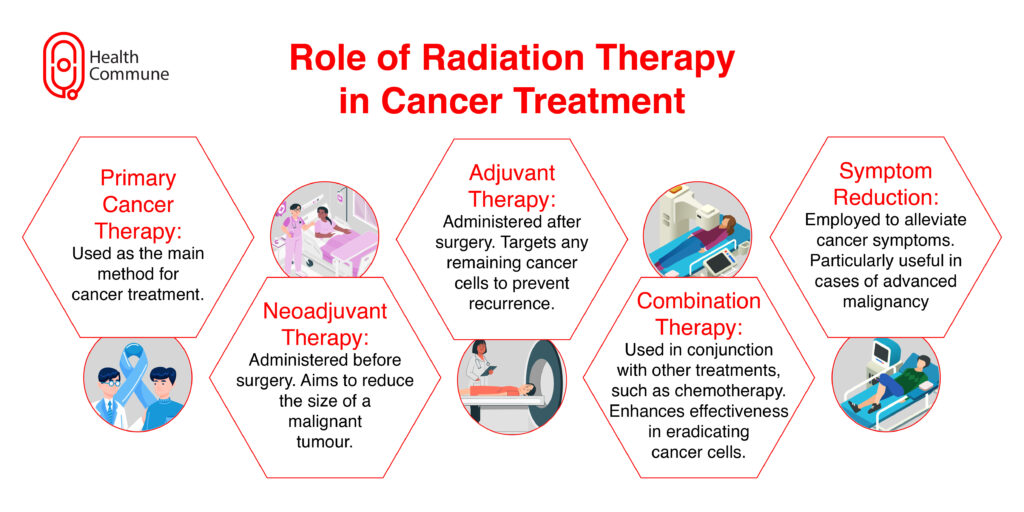What is radiation therapy?
Radiation therapy is a type of cancer therapy that uses high-intensity radiation beams to destroy and shrink the tumour cells, This works by damaging the genetic material of the tumour cells called the DNA. If these cancer cells are unable to repair this DNA, the cells will not be able to grow, and they may die.
What are the types of radiation therapy?
Radiation therapy is mainly of 2 types:
1. External beam radiation
- The most commonly used type of radiotherapy
- Radiation is provided from a source outside the body. If necessary, it can be applied to treat large portions of the body.
The different types of external beam radiation include:
- Three-dimensional conformal radiation therapy (3D-CRT)
- Uses computed tomography (CT) or magnetic resonance imaging (MRI) scans to create precise 3-dimensional images of the malignancy.
- These pictures are then used as a guide for precisely delivering the radiation beam with minimal damage to the healthy tissue.
- Intensity-modulated radiation therapy (IMRT)
- Compared to standard 3D-CRT, IMRT more effectively targets the tumour while avoiding healthy tissue.
- Image-guided radiation therapy (IGRT)
- The images of the malignancy are taken before and during the treatment, while the machine is delivering radiation.
- Hence, radiation is delivered more accurately
- Highly useful for radiotherapy of cancers located close to vital structures and on structures that move during or between treatments.
- Proton beam treatment
- Proton beam therapy uses protons in place of x-rays
- Proton is a positively charged particle with high energy
- Studies have shown that it poses fewer adverse effects on adjacent healthy tissues
- Stereotactic radiation therapy (SRT)
- In this therapy, a small tumour area receives a strong, focused dose of radiation
- The patient needs to be stable throughout therefore; moving parts are limited by a head frame.
- SRT is frequently administered in a single session or in less than ten sessions.
2. Internal radiation therapy (Brachytherapy)
- During this treatment, radioactive material is inserted, or placed within, or close to the cancerous tissues.
- The seeds, capsules, or implants thus placed, emit radiation that destroys the cancerous tissue with minimal damage to the surrounding healthy tissues.
Internal radiation therapy includes:
- Permanent implants are small radioactive steel seeds that come in the size of capsules similar to a rice grain. They provide the majority of the radiation therapy around the implant area.
- Temporary internal radiation therapy is a kind of radiation therapy that can be administered via a needle, a catheter, or specialised applicators. The duration of the radiation’s presence in the body ranges from a few minutes to a few days.

What are the other types of radiation therapy?
- Intraoperative radiation therapy (IORT)
- Delivers radiation to the tumours during surgery using an external or internal beam.
- The procedure also allows for the movement of healthy tissues so that they are not damaged.
- Systemic radiation therapy
- Is a therapy in which radioactive material is injected or ingested by patients.
- Urine, saliva, and perspiration are three ways that radioactive material leaves the body.
- Intraoperative radiation therapy (IORT)
- Uses monoclonal antibodies, which are proteins that get attracted to specific markers present in the cancer cells, to deliver radiation to the tumours.
What are radiosensitizers?
- These are chemicals that make radiation therapy more effective at removing malignancies.
- Healthy tissues near the treatment region are shielded by radioprotectors.
- Fluorouracil (5-FU, Adrucil) and cisplatin are two examples (Platinol) of radiosensitizers, and amifostine (Ethyol) is a radioprotector.
What is the role of radiation therapy in the treatment of cancer?
At various points in your cancer treatment and for a variety of reasons, your doctor may offer radiation therapy as an option, including
- As the primary (main) method of cancer therapy
- In order to reduce the size of a malignant tumour prior to surgery (neoadjuvant therapy)
- To inhibit the growth of any cancer cells that may still be present after surgery (adjuvant therapy)
- Used with other therapies, such as chemotherapy, to eradicate cancer cells
- Help reduce cancer symptoms in cases of advanced malignancy
What types of cancer does radiation therapy treat?
External beam radiation usually treats the following types of cancer:
- Breast cancer
- Lung cancer
- Prostate cancer
- Colon cancer
- Cancers of the head or neck
Internal radiation usually treats body parts like:
- Cervix
- Vagina
- Uterus
- Rectum
- Head and neck
- Eye
Also recommended for cancers like:
- Prostate
- Brain
- Lung
- Skin
- Breast
- Oesophagus
- Anus
- Bladder
How do I prepare before radiation therapy?
A doctor will evaluate the patient, inquire about their health, and discuss the treatment plan with the patient.
- A doctor will evaluate the patient, inquire about their health, and discuss the treatment plan.
- A planning meeting between a radiation oncologist and radiation therapist for a patient who agrees to receive external beam radiation is called a simulation.
- To indicate where to direct the energy beams, the radiation therapist may leave tiny scars on the patient’s skin. These stains may be tattoos or temporary marks.
- In order to make sure that a patient is receiving radiation therapy in the proper position, medical experts may also make a body mould.
- It may be necessary for someone getting radiation therapy to the head or neck to wear a face mask to keep their head in position during treatment.
What are the procedures done during radiation therapy?
External radiation beam
- Usually, a patient receives external beam radiation therapy while lying on a table underneath a huge machine.
- The radiation therapist will place the patient in the machine before leaving the room and entering another room.
- Patients are required to remain still throughout the procedure but need not hold their breath. There will be whirring, clicking, and vacuum cleaner-like noises coming from the device.
- The patient can communicate with the radiation therapist while receiving treatment through a speaker system in the room.
Internal radiation therapy
- The radioactive implant is inserted by the medical team during brachytherapy using a catheter or a larger instrument called an applicator.
- The physician will arrange the catheter or applicator and then insert the radiation source inside of it.
- Before the doctor removes the implant, it may occasionally stay inside the body for a few days.
- In certain cases, the implant may be placed in the body for 10 to 20 minutes, and the subsequent treatments will be over a period of several weeks.
- The physician will take out the catheter or applicator once the prescribed course of treatment is finished.
- An implant may occasionally stay in the body indefinitely, but it stops producing radiation after some time.





